
CHAPTER 20
Agriculture: Economics and Policy
A. Short-Answer, Essays, and Problems
1. Describe the diversity in the agriculture industry as it relates to farm commodities.
3. Why study the economics of agriculture in the United States? Give five reasons.
4. Describe the short-run situation in U.S. agriculture. What are its causes?
5. Depict the following scenarios on the graph provided below.
6. Explain why the demand for food is inelastic in terms of the substitution effect and diminishing returns.

you know?
8. Why would a farmer continue farming in the short run, even though his ATC was greater than the price he
received for his crops?
9. Discuss the fixed and variable costs of operating a farm. Which makes up a greater percentage of the total
costs?
10. How do U.S. exports of agricultural products affect the demand for agricultural products?
12. (Consider This) What are some risk management techniques used by farmers to reduce the uncertainty in
farming?
14. Why has agriculture become a declining industry over the past half century? Explain.
16. Graphically show the effect of price supports on the agricultural market.
17. What has been the rationale made over the years to justify government subsidies for agriculture?
18. Why are the prices received by farmers less stable than the prices paid by farmers?
19. The following table gives the index of prices farmers paid in three different years. The price farmers
2
125
_____
4.25
_____%
3
175
_____
5.00
_____%
20. What are the major economic effects on output, prices, and farmers’ income from government price
supports that set minimum prices for farm products?
21. Explain the economic effects of farm price supports on society in terms of the allocation of resources to
agriculture and three other social costs.
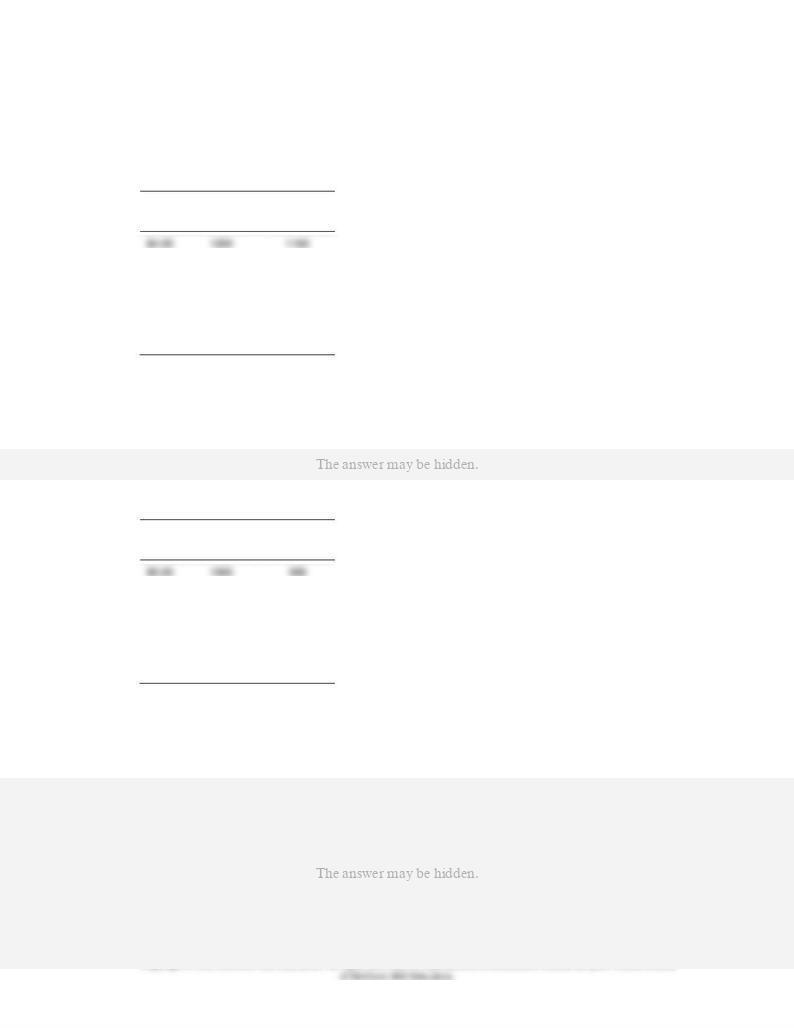
22. What are the environmental costs of price support programs for farmers?
23. Describe the international costs associated with farm price supports.
24. In columns 1 and 2 in the following table is a demand schedule for agricultural product A.
(1)
Price
(2)
Bushels of A
demanded
(3)
Bushels of A
demanded
3.60
1240
1200
3.20
1280
1240
2.80
1320
1280
2.40
1360
1320
2.00
1400
1360
1.60
1440
1400
1.20
1480
1440
(a) What is the characteristic of elasticity in the price range given?
(b) By how much would the income of producers change if the amount of A produced should increase
from 1200 to 1400 bushels?
(c) If the amount of A produced were 1400 bushels and the demand for A decreased from that shown in
columns 1 and 2 to that shown in columns 1 and 3, what would happen to the income of farmers?
25. In columns 1 and 2 in the following table is a demand schedule for agricultural product A.
(1)
Price
(2)
Bushels of A
demanded
(3)
Bushels of A
demanded
4.50
1025
1000
4.00
1050
1025
3.50
1075
1050
3.00
1100
1075
2.50
1125
1100
2.00
1150
1125
1.50
1175
1150
(a) What is the characteristic of elasticity in the price range given?
(b) By how much would the income of producers change if the amount of A produced should increase
from 1000 to 1100 bushels?
(c) If the amount of A produced were 1100 bushels and the demand for A decreased from that shown in
columns 1 and 2 to that shown in columns 1 and 3, what would happen to the income of farmers?
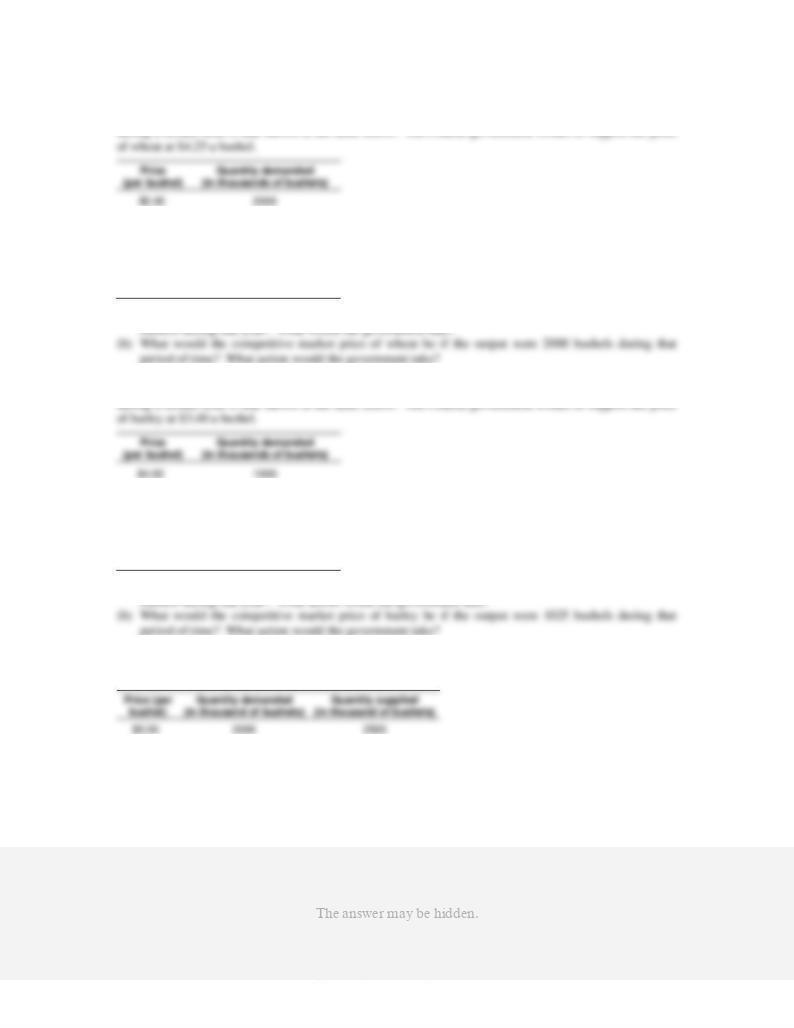
26. Use the following information and table to answer the next two questions. Suppose the demand for wheat
4.75
2040
4.50
2080
4.25
2120
4.00
2160
3.75
2200
3.50
2240
(a) What would the competitive market price of wheat be if the output of wheat were 2200 thousand
27. Use the following information and table to answer the next two questions. Suppose the demand for wheat
3.80
1025
3.60
1050
3.40
1075
3.20
1100
3.00
1125
2.80
1150
(a) What would the competitive market price of barley be if the output of barley were 1100 thousand
28. The table below provides price, demand and supply information for soybeans. Use this information to
answer the following questions.
4.80
2025
2400
4.60
2050
2300
4.40
2075
2200
4.20
2100
2100
4.00
2125
2000
3.80
2150
1900
3.60
2175
1800
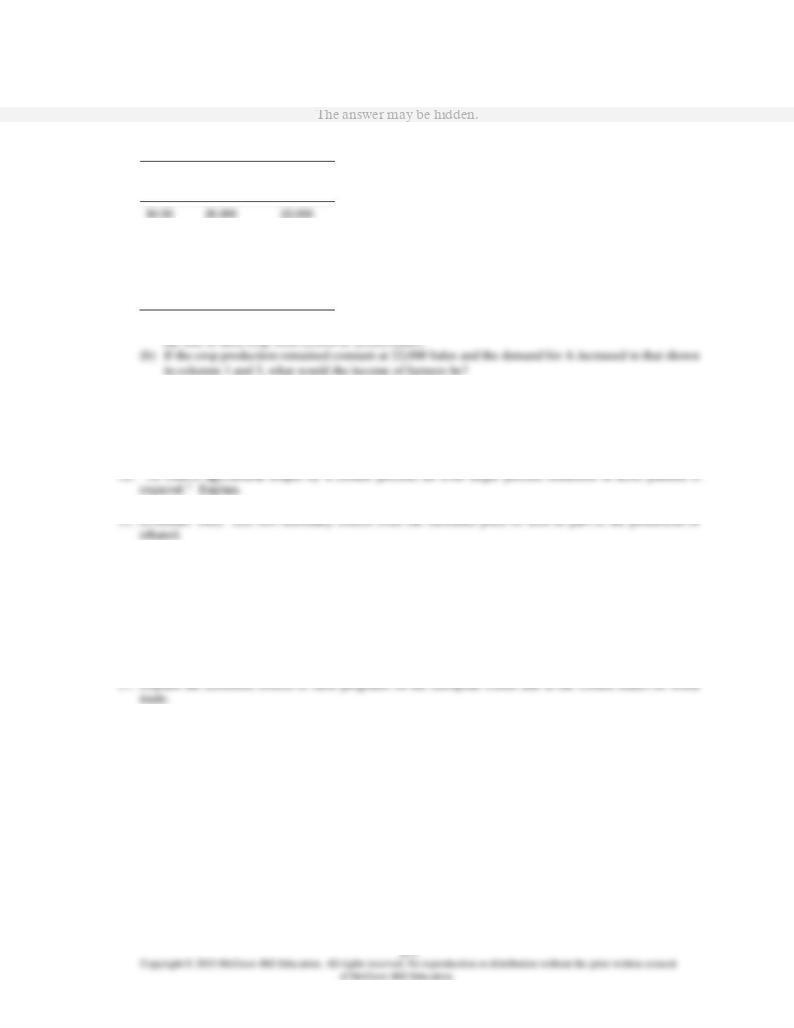
(c) Suppose the government decides to maintain the price at $4.40. What would be the impact on the
29. The demand schedule for agricultural product A is given in columns 1 and 2 of the following table.
(1)
Price
(2)
Bales of A
demanded
(3)
Bales of A
demanded
4.25
20,400
22,400
4.00
20,800
22,800
3.75
21,200
23,200
3.50
21,600
23,600
3.25
22,000
24,000
3.00
22,400
24,400
(a) What would happen to the income of farmers if farmers were persuaded by the government to reduce
30. What supply and what demand approaches have been used to reduce surpluses of farm commodities?
31. “More research should be devoted to projects which will reduce rather than increase agricultural surpluses.”
Is this a sound approach? Explain.
34. What have been three major criticisms of agricultural policies over the past half-century?
35. How does the politics of farm policy explain why costly and expensive farm programs have persisted in the
United States despite a decline in the farm population and in the political power of the farm vote?
36. What factors explain why there has been a decline in the political support for agricultural subsidies in
recent years?
38. Suppose that the U.S. government is trying to garner support from Central American countries to pass the
newest free trade agreement, Central American Free Trade Agreement (CAFTA). Why might Central
American countries argue that in terms of agricultural products, trade with the United States is not really
truly competitive?
39. What are the major provisions of the Freedom to Farm Act of 1996?
40. The Freedom to Farm Act of 1996 was supposed to get the government out of agriculture. So, why was
emergency aid been given to farmers in recent years?
41. Describe the purpose of the Food, Conservation and Energy Act of 2008.
42. Discuss the continuing problem with farm policy after the Food, Conservation and Energy Act of 2008.
43. (Last Word) Describe the economic effects of the U.S. price supports and import quotas for sugar.

1. Describe the diversity in the agriculture industry as it relates to farm commodities.
2. What is the difference between farm commodities and food products? How does the number of competing
firms change as farm commodities are processed into food?
3. Why study the economics of agriculture in the United States? Give five reasons.
4. Describe the short-run situation in U.S. agriculture. What are its causes?
5. Depict the following scenarios on the graph provided below.
(a) An unexpected drought occurs.
(b) A news special links high fructose corn syrup and diabetes.
(c) Technology increases the yield per acre.
(d) A population boom occurs in the United States.
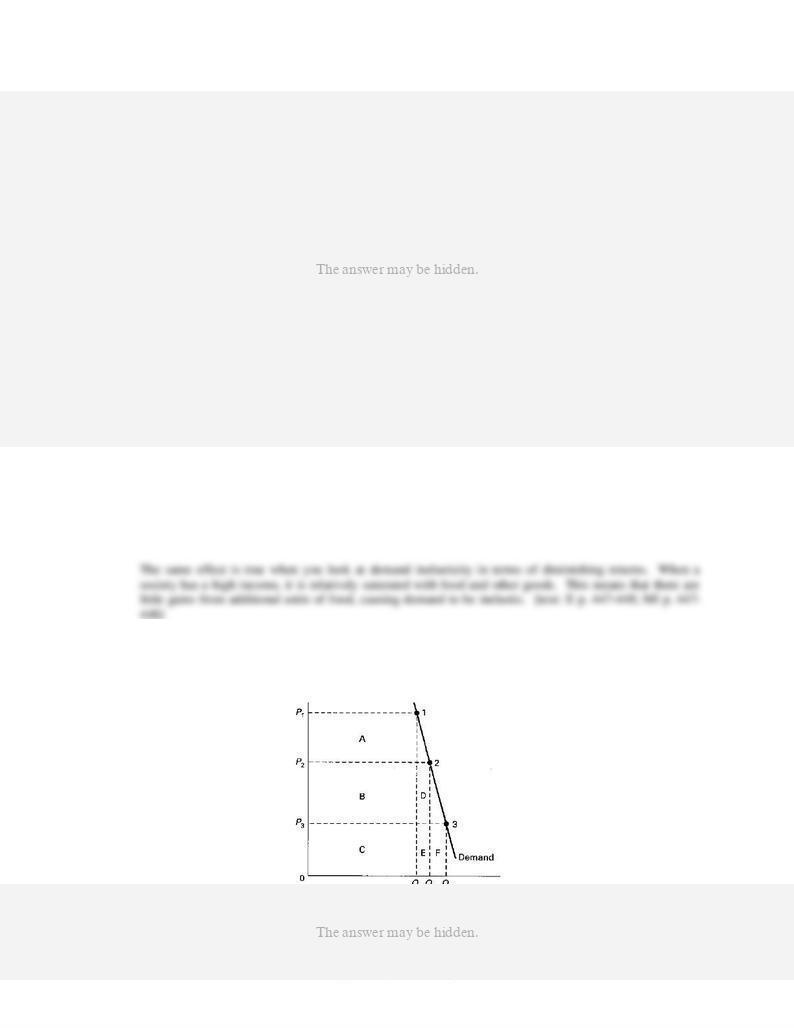
6. Explain why the demand for food is inelastic in terms of the substitution effect and diminishing returns.
When the price of a good such as food falls, consumers usually shift demand from goods whose prices have
remained constant to the reduced-price food. However, the substitution effect is modest in terms of food,
as consumers will not consume an endlessly larger and larger amount of food. Thus, even as the price for a
certain food commodity falls substantially, demand may not actually increase by much.
7. Use the below graph to show what happens to total revenue when: (a) price falls from P1 to P2; (b) price
rises from P3 to P2. Explain your answer in terms of areas of total revenue gained or lost using the
alphabetical letters representing different areas on the graph. (c) Is demand elastic or inelastic? How do
you know?
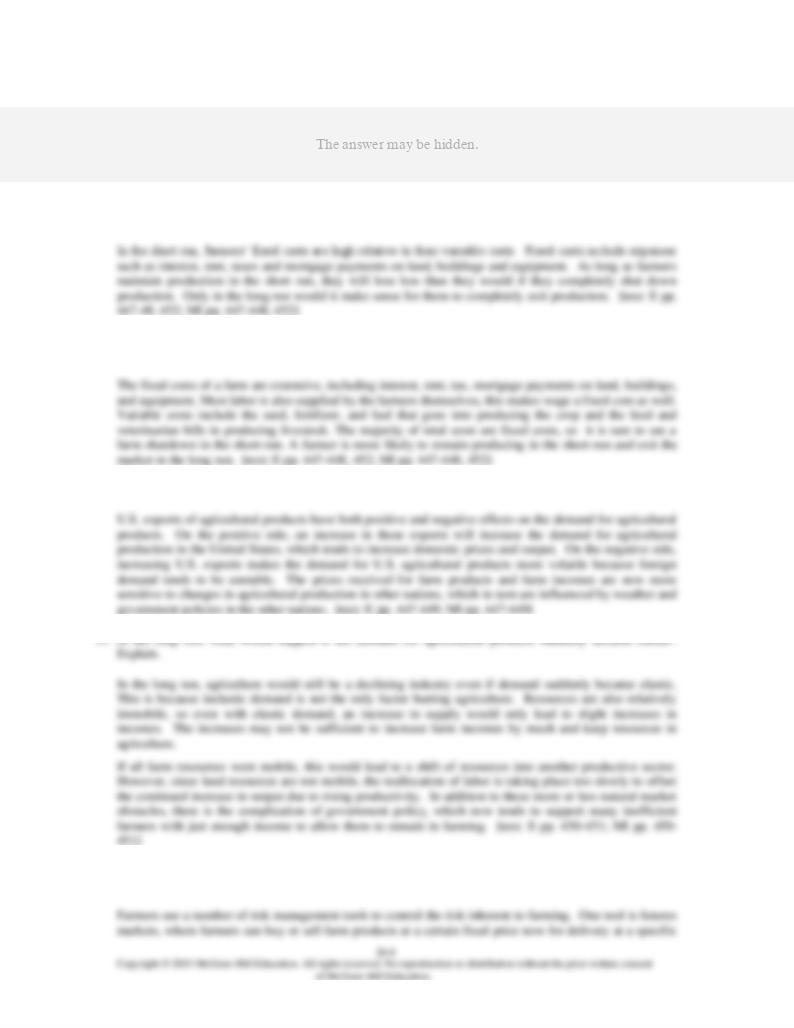
(b) Total revenue when price is P3 is areas C + E + F. When price rises to P2, total revenue is areas B + C
8. Why would a farmer continue farming in the short run, even though his ATC was greater than the price he
received for his crops?
9. Discuss the fixed and variable costs of operating a farm. Which makes up a greater percentage of the total
costs?
10. How do U.S. exports of agricultural products affect the demand for agricultural products?
12. (Consider This) What are some risk management techniques used by farmers to reduce the uncertainty in
farming?
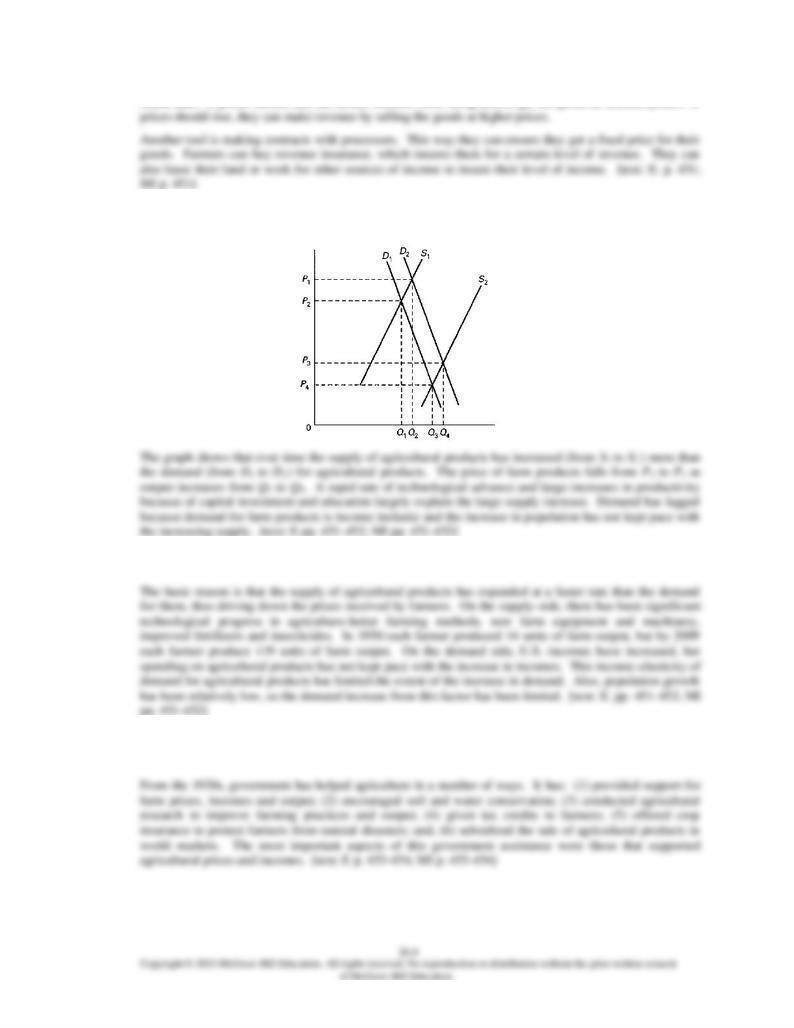
future date. If prices should fall, the farmer benefits from being able to get the goods at reduced prices. If
13. Use the below axes to draw a supply and demand diagram that illustrates the long-run situation in
agriculture. Explain the problem.
14. Why has agriculture become a declining industry over the past half century? Explain.
15. In what ways did government subsidize agriculture over the past sixty years? What were the most
important aspects of this assistance?

16. Graphically show the effect of price supports on the agricultural market.
17. What has been the rationale made over the years to justify government subsidies for agriculture?
18. Why are the prices received by farmers less stable than the prices paid by farmers?
19. The following table gives the index of prices farmers paid in three different years. The price farmers
2
125
_____
4.25
_____%
3
175
_____
5.00
_____%
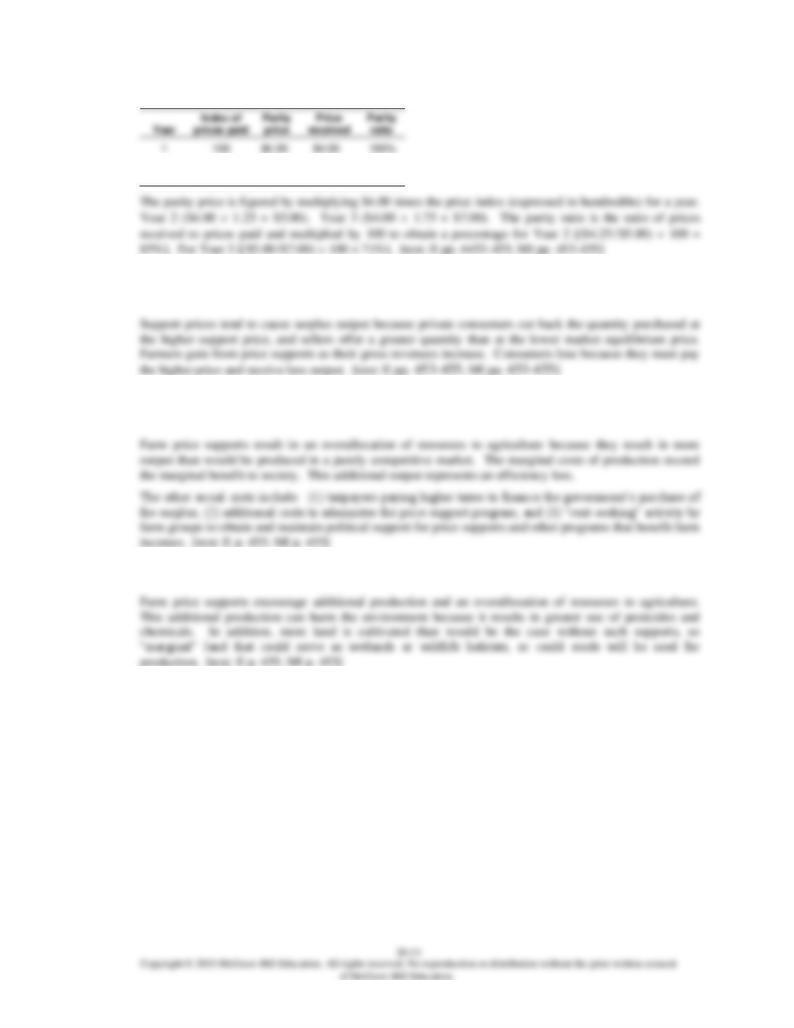
2
125
5.00
4.25
85%
3
175
7.00
5.00
71%
20. What are the major economic effects on output, prices, and farmers’ income from government price
supports that set minimum prices for farm products?
21. Explain the economic effects of farm price supports on society in terms of the allocation of resources to
agriculture and three other social costs.
22. What are the environmental costs of price support programs for farmers?
23. Describe the international costs associated with farm price supports.
Farm price supports create distortions of prices in world markets. Most agricultural products are marketed
on a worldwide basis. Farm price supports encourage more productions than would be the case without
them. This additional production tends to drive down prices on world markets and make it difficult to
achieve economic efficiency within a nation and around the world. Thus, there is inefficiency
(overallocation) of resources worldwide to agricultural production. The price supports also affect trade
policy between nations. Nations may impose tariffs or quotas to prevent the dumping of surplus farm
products on their domestic markets, thus undercutting free trade among nations. [text: E p. 455; MI p. 455]
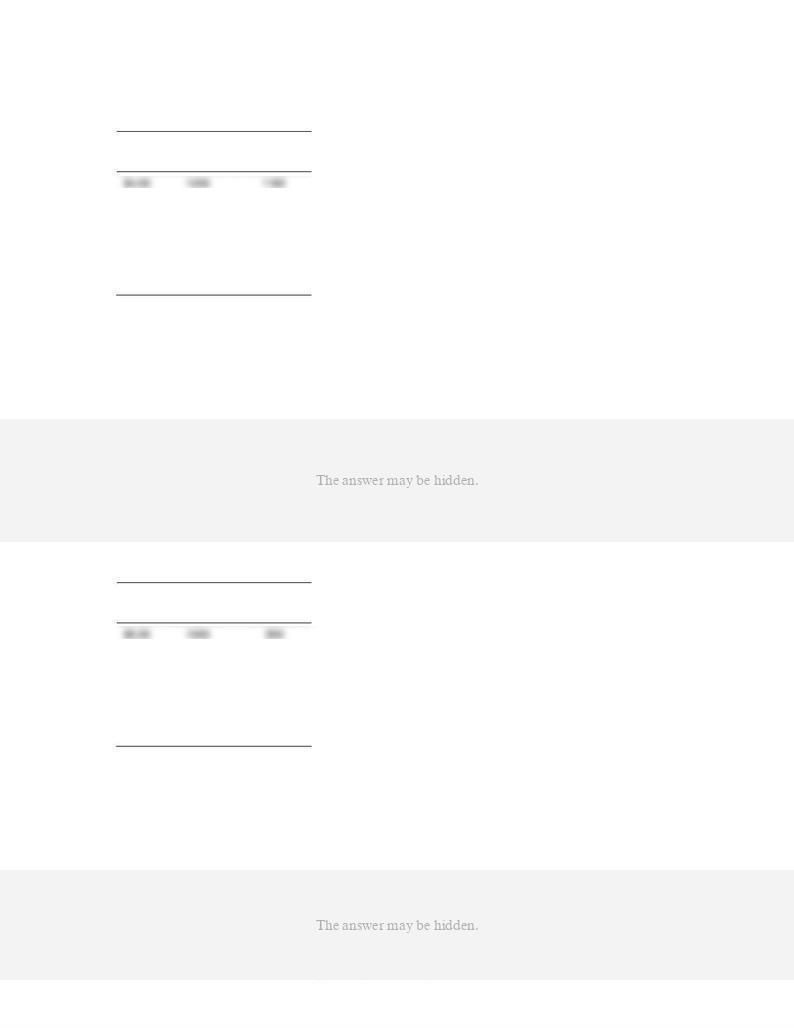
24. In columns 1 and 2 in the following table is a demand schedule for agricultural product A.
(1)
Price
(2)
Bushels of A
demanded
(3)
Bushels of A
demanded
3.60
1240
1200
3.20
1280
1240
2.80
1320
1280
2.40
1360
1320
2.00
1400
1360
1.60
1440
1400
1.20
1480
1440
(a) What is the characteristic of elasticity in the price range given?
(b) By how much would the income of producers change if the amount of A produced should increase
from 1200 to 1400 bushels?
(c) If the amount of A produced were 1400 bushels and the demand for A decreased from that shown in
columns 1 and 2 to that shown in columns 1 and 3, what would happen to the income of farmers?
(d) Assume that the government supports a price of $3.60, that the demand for A is that shown in columns
1 and 2, and that farmers grow 1440 bushels of A. What will be the total income of farmers at the
25. In columns 1 and 2 in the following table is a demand schedule for agricultural product A.
(1)
Price
(2)
Bushels of A
demanded
(3)
Bushels of A
demanded
4.50
1025
1000
4.00
1050
1025
3.50
1075
1050
3.00
1100
1075
2.50
1125
1100
2.00
1150
1125
1.50
1175
1150
(a) What is the characteristic of elasticity in the price range given?
(b) By how much would the income of producers change if the amount of A produced should increase
from 1000 to 1100 bushels?
(c) If the amount of A produced were 1100 bushels and the demand for A decreased from that shown in
columns 1 and 2 to that shown in columns 1 and 3, what would happen to the income of farmers?
(d) Assume that the government supports a price of $4.50, that the demand for A is that shown in columns
1 and 2, and that farmers grow 1150 bushels of A. What will be the total income of farmers at the

(d) The total income of the farmers producing product A when they receive the support price of $4.50 per
26. Use the following information and table to answer the next two questions. Suppose the demand for wheat
4.75
2040
4.50
2080
4.25
2120
4.00
2160
3.75
2200
3.50
2240
(a) What would the competitive market price of wheat be if the output of wheat were 2200 thousand
bushels during that year? What would the government take?
(b) What would the competitive market price of wheat be if the output were 2000 bushels during that
27. Use the following information and table to answer the next two questions. Suppose the demand for wheat
3.80
1025
3.60
1050
3.40
1075
3.20
1100
3.00
1125
2.80
1150
(a) What would the competitive market price of barley be if the output of barley were 1100 thousand
bushels during that year? What action would the government take?
(b) What would the competitive market price of barley be if the output were 1025 bushels during that
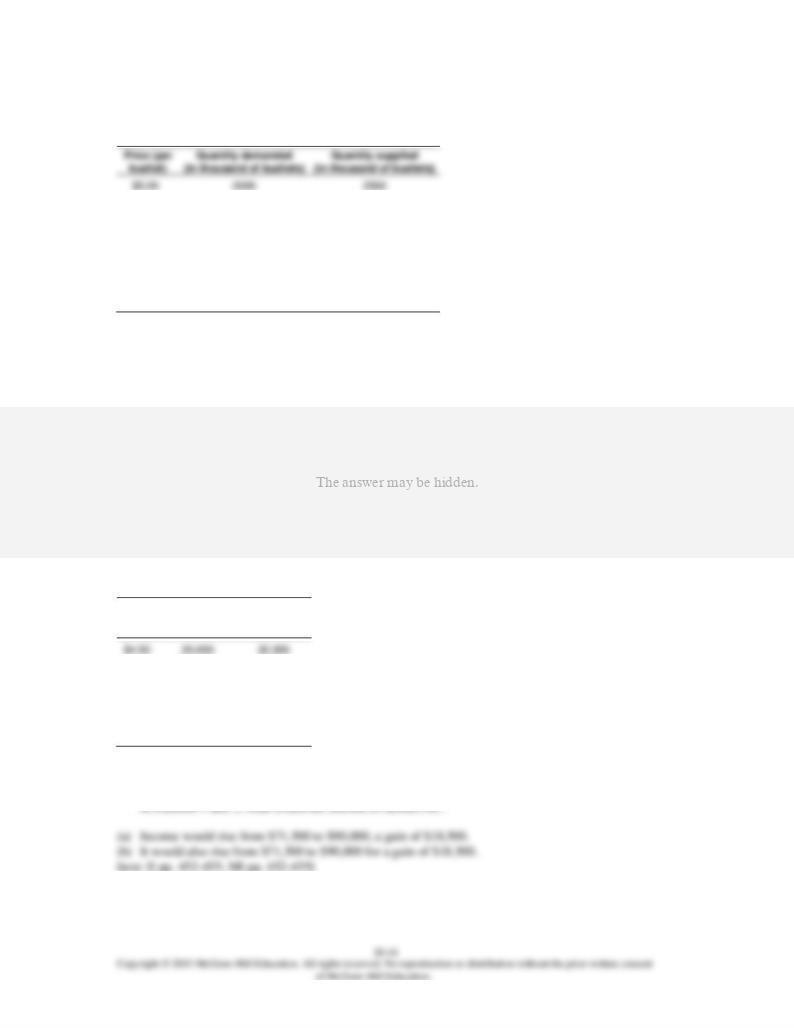
28. The table below provides price, demand and supply information for soybeans. Use this information to
answer the following questions.
4.80
2025
2400
4.60
2050
2300
4.40
2075
2200
4.20
2100
2100
4.00
2125
2000
3.80
2150
1900
3.60
2175
1800
3.40
2200
1700
(a) Without government intervention, what is the equilibrium price and quantity for soybeans? What is
the producer surplus gained by the farmers?
(b) Suppose farmers produce a bumper crop this year, increasing quantity by 250 bushels at every price.
What is the equilibrium price and quantity? What is the new consumer surplus?
(c) Suppose the government decides to maintain the price at $4.40. What would be the impact on the
29. The demand schedule for agricultural product A is given in columns 1 and 2 of the following table.
(1)
Price
(2)
Bales of A
demanded
(3)
Bales of A
demanded
4.25
20,400
22,400
4.00
20,800
22,800
3.75
21,200
23,200
3.50
21,600
23,600
3.25
22,000
24,000
3.00
22,400
24,400
(a) What would happen to the income of farmers if farmers were persuaded by the government to reduce
the size of their crop from 22,000 to 20,000 bales?
(b) If the crop production remained constant at 22,000 bales and the demand for A increased to that shown
30. What supply and what demand approaches have been used to reduce surpluses of farm commodities?
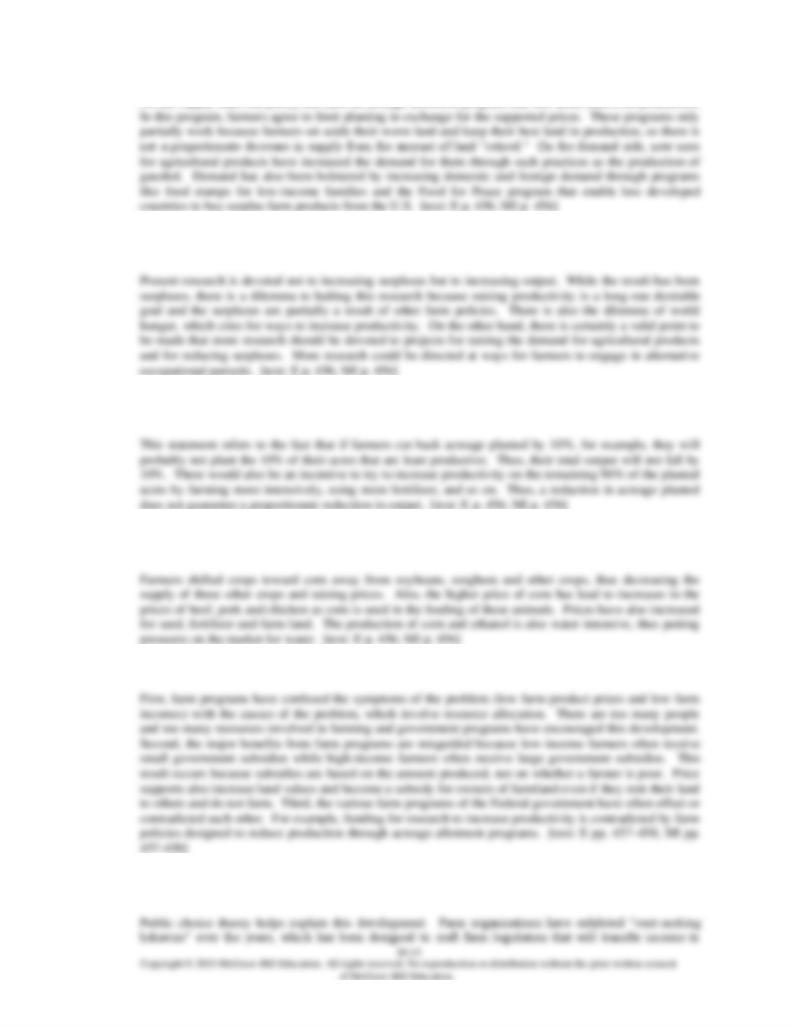
On the supply side, one policy has been an acreage allotment program that sets aside land from production.
31. “More research should be devoted to projects which will reduce rather than increase agricultural surpluses.”
Is this a sound approach? Explain.
32. “To reduce agricultural output by a certain percent, an even larger percent reduction in acres planted is
required.” Explain.
33. (Consider This) List two secondary effects from the increased price of corn as part of the promotion of
ethanol.
34. What have been three major criticisms of agricultural policies over the past half-century?
35. How does the politics of farm policy explain why costly and expensive farm programs have persisted in the
United States despite a decline in the farm population and in the political power of the farm vote?
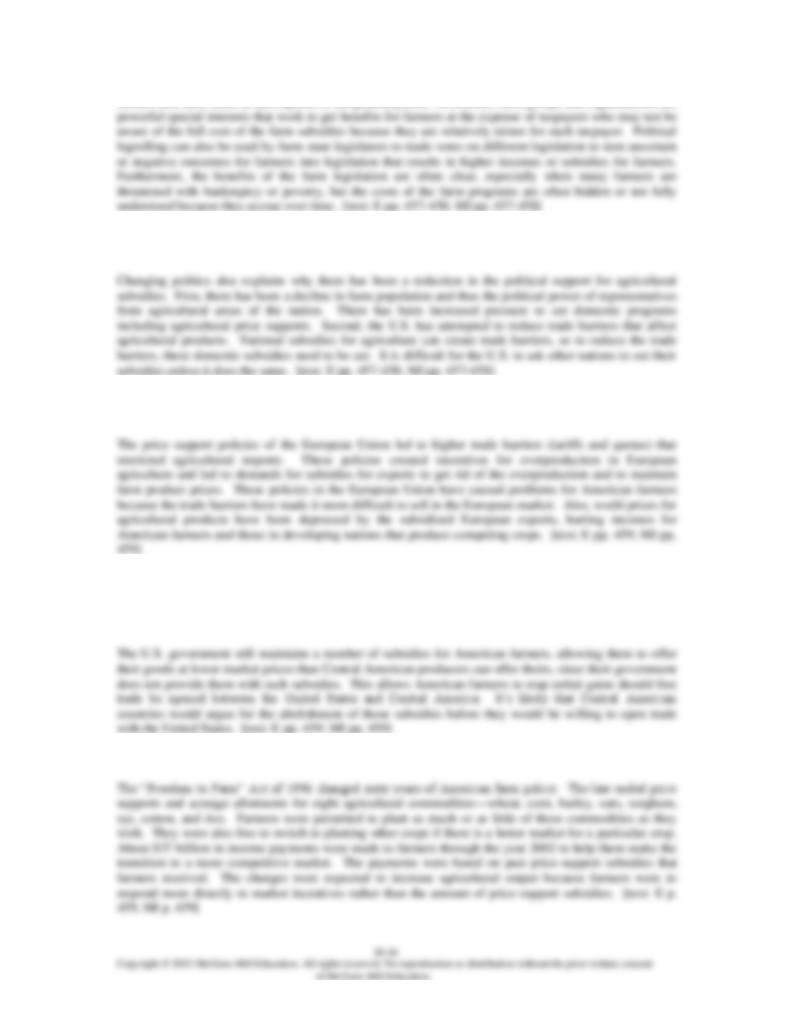
farmers and farm states at the expense of the general public. In essence, farm groups and organizations are
36. What factors explain why there has been a decline in the political support for agricultural subsidies in
recent years?
37. Explain the economic effects of farm programs on the European Union and in the United States on world
trade.
38. Suppose that the U.S. government is trying to garner support from Central American countries to pass the
newest free trade agreement, Central American Free Trade Agreement (CAFTA). Why might Central
American countries argue that in terms of agricultural products, trade with the United States is not really
truly competitive?
39. What are the major provisions of the Freedom to Farm Act of 1996?
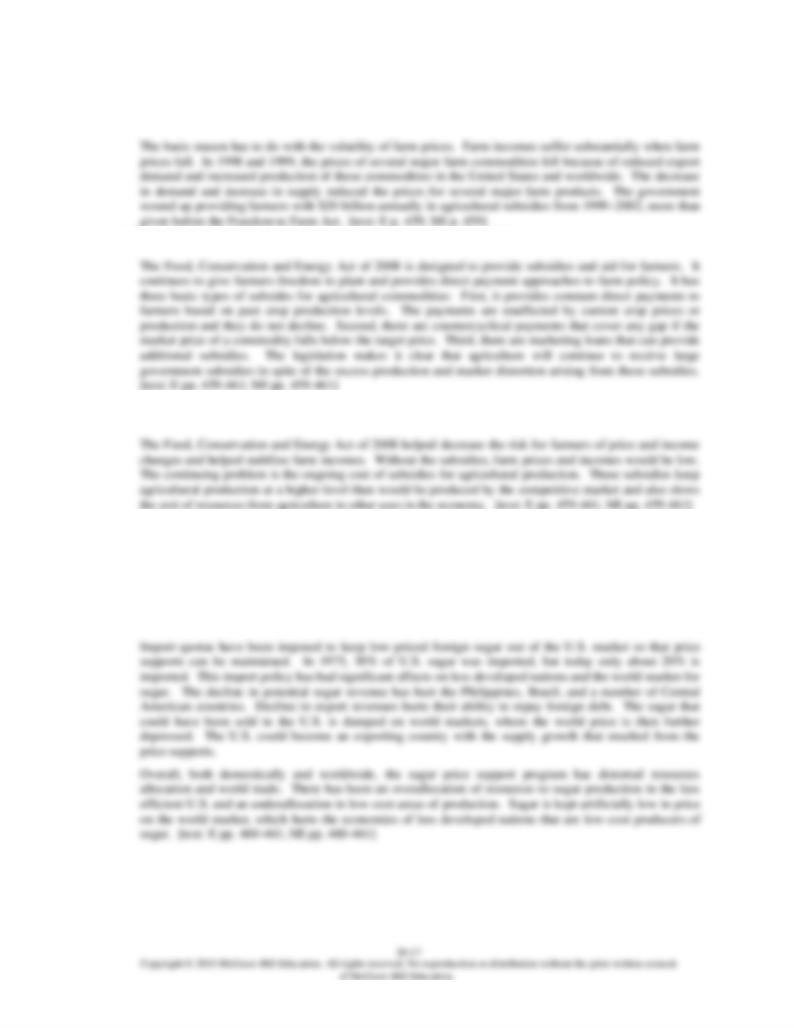
40. The Freedom to Farm Act of 1996 was supposed to get the government out of agriculture. So, why was
emergency aid been given to farmers?
41. Describe the purpose of the Food, Conservation and Energy Act of 2008.
42. Discuss the continuing problem with farm policy after the Food, Conservation and Energy Act of 2008.
43. (Last Word) Describe the economic effects of the U.S. price supports and import quotas for sugar.
Price supports and import quotas have doubled U.S. sugar prices relative to world markets prices. The
estimated cost to consumers is between 1.5 billion and $1.9 billion per year. The effect is regressive
because poor households spend a larger percentage of their income on food (including sugar) than do high-
income households. Sugar growers receive benefits that are estimated to be twice the nation’s average
family income. In fact, many farms receive more than a million dollars in subsidies.